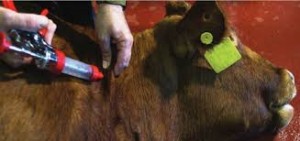Health Protocol for Maximum Profits With Cattle
go.ncsu.edu/readext?401985
en Español / em Português
El inglés es el idioma de control de esta página. En la medida en que haya algún conflicto entre la traducción al inglés y la traducción, el inglés prevalece.
Al hacer clic en el enlace de traducción se activa un servicio de traducción gratuito para convertir la página al español. Al igual que con cualquier traducción por Internet, la conversión no es sensible al contexto y puede que no traduzca el texto en su significado original. NC State Extension no garantiza la exactitud del texto traducido. Por favor, tenga en cuenta que algunas aplicaciones y/o servicios pueden no funcionar como se espera cuando se traducen.
Português
Inglês é o idioma de controle desta página. Na medida que haja algum conflito entre o texto original em Inglês e a tradução, o Inglês prevalece.
Ao clicar no link de tradução, um serviço gratuito de tradução será ativado para converter a página para o Português. Como em qualquer tradução pela internet, a conversão não é sensivel ao contexto e pode não ocorrer a tradução para o significado orginal. O serviço de Extensão da Carolina do Norte (NC State Extension) não garante a exatidão do texto traduzido. Por favor, observe que algumas funções ou serviços podem não funcionar como esperado após a tradução.
English
English is the controlling language of this page. To the extent there is any conflict between the English text and the translation, English controls.
Clicking on the translation link activates a free translation service to convert the page to Spanish. As with any Internet translation, the conversion is not context-sensitive and may not translate the text to its original meaning. NC State Extension does not guarantee the accuracy of the translated text. Please note that some applications and/or services may not function as expected when translated.
Collapse ▲In the cow/calf business, fall profits depend heavily on decisions producers make in the spring for both cows and calves. Keeping calves healthy and prepared for top marketing programs, as well as getting cows rebred, are universal keys to ranching success. Here are seven springtime management suggestions that will provide reproductive protection through breeding and gestation, plus build strong calf immunity to maximize their growth potential and be immunologically prepared to transition to the feedlot in the fall.
- Work with your veterinarian to build a health protocol specific to your herd. Your veterinarian is the best resource you have to identify the pathogens and disease challenges that are most important in your area. Vaccinations for cows should be focused on optimizing conception and preventing abortion, while prevention of respiratory disease is the most important element of calf vaccinations.
- Vaccinate cows in the spring whenever possible. Three to six weeks before breeding is the ideal time to vaccinate cows for maximum reproductive protection. The focus is to protect against reproductive pathogens that can interfere with conception or trigger abortions. And don’t forget to include trichomoniasis testing for bulls in your health protocol. There are no vaccines for trichomoniasis, so testing is the best option available.
- Vaccinate calves for respiratory protection with a target on fall marketing health programs. Spring is often our first opportunity to prime the calf’s immune system so they rapidly respond to weaning vaccinations. The viruses of concern that need to be included in a vaccination program are Infectious Bovine Rhinotracheitis (IBR), Bovine Viral Diarrhea (BVD) and Bovine Respiratory Syncytial Virus (BRSV). The most prominent players for bacterial pneumonia are Mannheimia haemolytica and Pasteurella multocida. Use intranasal vaccines in calves younger than five months of age. Intranasal vaccines also are less stressful on the young calf than vaccines given under the skin and escape interference from maternal antibodies in colostrum.
- Eliminate internal parasites before turnout. There’s no shortage of evidence that shows if parasites are effectively eliminated, the cow will eat more, milk better and produce a heavier calf. Because of documented parasite resistance to ivermectin products, the most effective strategy to control internal parasites should include the active ingredient fenbendazole. Consult with your veterinarian to assist with the diagnosis, treatment and control strategies for internal parasites.
- Control pinkeye with vaccination and management. Because pinkeye is a significant health problem in many parts of the country, a combination of vaccination and fly control is recommended for complete control. Fly tags in cows and calves can be very helpful in areas with heavy fly pressure.
- Consider implanting all calves at branding. Implanting a calf will add 20 to 25 pounds to the weaning weight and an extra $40 in revenue for just a $1.25-per-head investment. Unless a producer has a solid contract for a “natural” program that guarantees a premium of $40 or more, implants should be part of his spring turnout program for all calves older than one month of age.
After you have taken the steps to ensure optimal calf health, be sure to document the products and practices you have used. A signed certificate, especially one signed by your veterinarian, will add value to your calves. Documentation should comprise of vaccination, parasite control and other treatments, including the product, what it’s for and the date applied. Print a copy to accompany the calves when they go to market. Buyers pay $15 to $35 more per head for calves with that kind of documented health history.
Merck Animal Health





